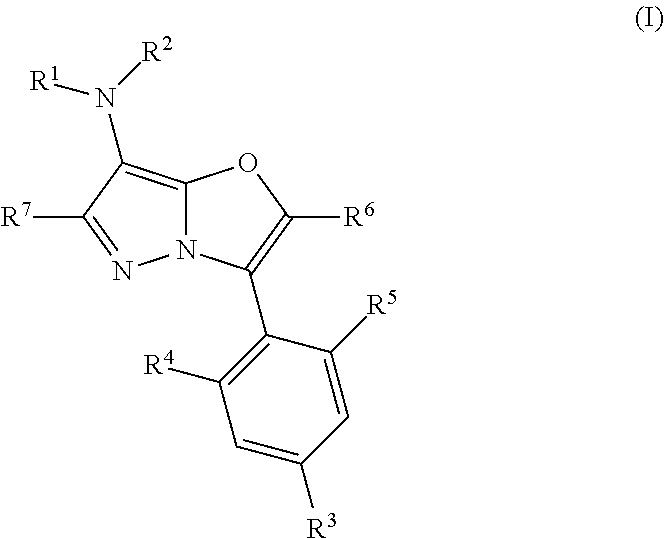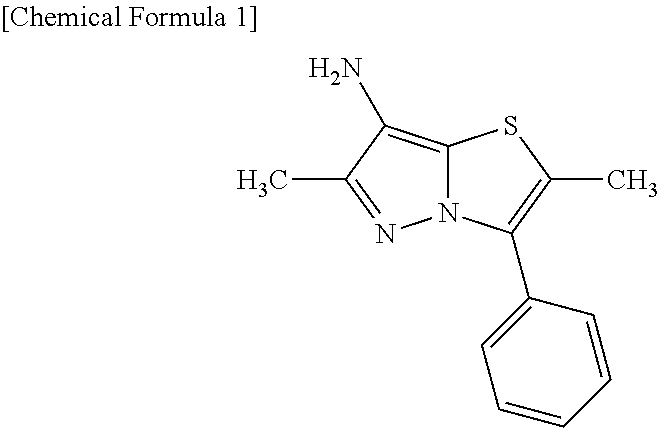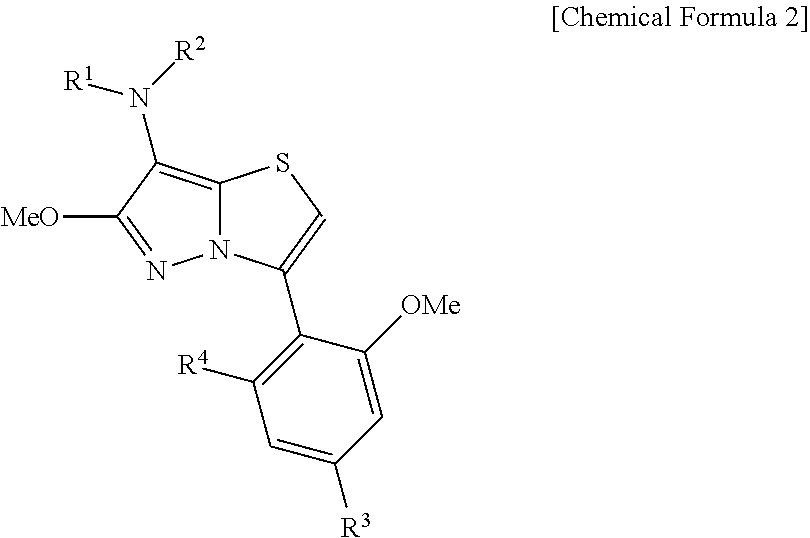Pyrazolooxazole compound
a compound and pyrazolooxazole technology, applied in the field of compounds, can solve the problems of not being able to have sufficient pharmacological activity, not necessarily sufficient in terms of superior crf receptor antagonism, etc., and achieve the effects of reducing depression, anxiety, and reducing depression
- Summary
- Abstract
- Description
- Claims
- Application Information
AI Technical Summary
Benefits of technology
Problems solved by technology
Method used
Image
Examples
production example 1-1
Diethyl Acetylmalonate
[0318]
[0319]To a toluene solution (22 mL) of diethyl malonate (1.6 g, 10 mmol) were added magnesium turnings (243 mg, 10 mol), ethanol (1.93 mL, 33 mmol) and carbon tetrachloride (250 μL, 2.59 mmol) while stirring at room temperature, and the reaction mixture was stirred for 30 minutes at room temperature. After further heated under reflux for 1 hour at 85° C., this reaction mixture was cooled to 0° C., and to the reaction mixture was added acetyl chloride (714 μL, 10 mmol), and the reaction mixture was stirred for 30 minutes at 0° C. After the reaction mixture was returned to room temperature and stirred for 3 days, 5% hydrochloric acid was added thereto at 0° C. The organic layer was washed with a saturated sodium hydrogen carbonate aqueous solution and brine, dried over anhydrous magnesium sulfate, and thereafter the solvent was distilled off under reduced pressure. The residue obtained was dried to yield the title compound (1.54 g, 7.62 mmol).
production example 1-2
Ethyl 5-methyl-3-oxo-2,3-dihydro-1H-pyrazolo-4-carboxylate
[0320]
[0321]To an ethanol solution (20 mL) of diethyl acetylmalonate (2.99 g, 14.8 mmol) was added hydrazine monohydrochloride (1.52 g, 22.2 mmol), and the reaction mixture was heated under reflux for 10 hours at 85° C. The reaction mixture was returned to room temperature, and the solvent was distilled off under reduced pressure. To the residue obtained was added diethyl ether, and the resulting solid was filtered. After washed with a small amount of diethyl ether, the solid was dried to yield the title compound (0.74 g, 4.35 mmol).
[0322]1H-NMR (CDCl3) δ: 1.39 (t, J=7.2 Hz, 3H), 2.48 (s, 3H), 4.37 (q, J=7.2 Hz, 2H).
production example 1-3
Ethyl 3-(2,4-dichlorophenyl)-6-methylpyrazolo[5,1-b][1,3]oxazole-7-carboxylate
[0323]
[0324]To an N,N-dimethylformamide solution (30 mL) of ethyl 5-methyl-3-oxo-2,3-dihydro-1H-pyrazolo-4-carboxylate (626 mg, 3.68 mmol) was added potassium carbonate (509 mg, 3.68 mmol), and the reaction mixture was stirred for 10 minutes at 50° C. To this reaction mixture was added an N,N-dimethylformamide solution (10 ml) of 2-bromo-2′,4′-dichloroacetophenone (986 mg, 3.68 mmol), and the resulting reaction mixture was further stirred for 1 hour. The reaction mixture was added to water, and extracted with ethyl acetate, and then, the organic layer was washed with water and brine, dried over magnesium sulfate, and the solvent was distilled off under reduced pressure. The dried residue mixed with p-toluenesulfonic acid monohydrate (700 mg, 3.68 mmol), acetic acid (21 mL) and toluene (60 mL), and the mixture was heated under reflux for 5 hours at 120° C. while removing water with a Dean-Stark apparatus. A...
PUM
| Property | Measurement | Unit |
|---|---|---|
| temperature | aaaaa | aaaaa |
| temperature | aaaaa | aaaaa |
| temperature | aaaaa | aaaaa |
Abstract
Description
Claims
Application Information
 Login to View More
Login to View More - R&D
- Intellectual Property
- Life Sciences
- Materials
- Tech Scout
- Unparalleled Data Quality
- Higher Quality Content
- 60% Fewer Hallucinations
Browse by: Latest US Patents, China's latest patents, Technical Efficacy Thesaurus, Application Domain, Technology Topic, Popular Technical Reports.
© 2025 PatSnap. All rights reserved.Legal|Privacy policy|Modern Slavery Act Transparency Statement|Sitemap|About US| Contact US: help@patsnap.com



